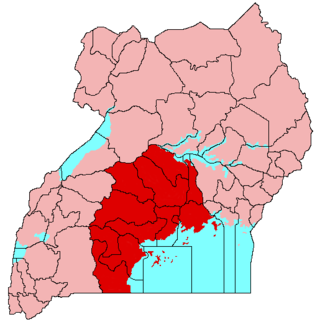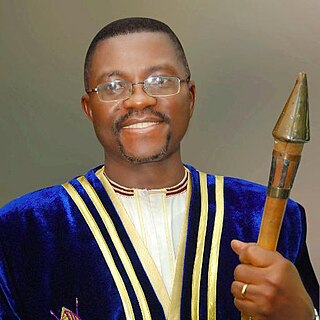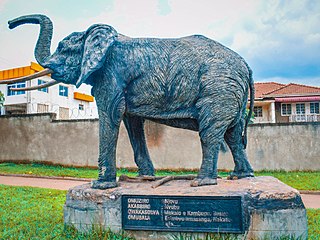
Buganda is a Bantu kingdom within Uganda. The kingdom of the Baganda people, Buganda is the largest of the traditional kingdoms in present-day East Africa, consisting of Uganda's Central Region, including the Ugandan capital Kampala. The 14 million Baganda make up the largest Ugandan region, representing approximately 16% of Uganda's population.

Danieri Basammula-Ekkere Mwanga II Mukasa was the 31st Kabaka of Buganda who ruled from 1884 until 1888 and from 1889 until 1897.
Kato Kintu Kakulukuku, known in Bunyoro as Kato Kimera was the first kabaka (king) of the Kingdom of Buganda. "Kintu" is an adopted by-name, chosen for Kintu, the name of the first person on earth in Buganda mythology. Kato Kintu gave himself the name "Kintu" to associate himself with the "father of all people", and he may have renamed his wife, from Nantuttululu to Nambi, because that was Kintu's wife's name.
Chwa I Nabakka was Kabaka (King) of the Kingdom of Buganda. He reigned during the mid 14th century. He was the 2nd Kabaka of Buganda.

Bees have been featured in myth and folklore around the world. Honey and beeswax have been important resources for humans since at least the Mesolithic period, and as a result humans' relationship with bees—particularly honey bees—has ranged from encounters with wild bees to keeping them agriculturally. Bees themselves are often characterized as magically imbued creatures and their honey as a divine gift.
Sir Andrew Benjamin Cohen was Governor of Uganda from 1952 to 1957.
Kintu is a mythological figure who appears in a creation myth of the people of Buganda, Uganda. According to this legend, Kintu was the first person on earth.
Ggulu is a translation for heaven in the Bantu language Luganda.
Warumbe or Walumbe is a character in the Ganda creation myth, the legend of Kintu. He is the son of Ggulu and the brother of Nambi. His name in the Luganda language means 'disease' or 'death' and he is responsible for death on Earth according to Gandan mythology.
Kaikuzi or Kayikuuzi is a character in the Gandan creation myth, The Legend of Kintu. He is the son of Ggulu. His name is translated as "the digger." He is responsible for attempting to rid the Earth of Walumbe, meaning "death" or "disease."
Mutebi Nnyonyintono Kiweewa was Kabaka of the Kingdom of Buganda from 2 August 1888 until 21 October 1888. He was the 32nd Kabaka of Buganda.

The Baganda also called Waganda, are a Bantu ethnic group native to Buganda, a subnational kingdom within Uganda. Traditionally composed of 52 clans, the Baganda are the largest people of the Bantu ethnic group in Uganda, comprising 16.5 percent of the population at the time of the 2014 census.
Wasswa Chwamale Mwanga Winyi was a reigning monarch of Bunyoro-Kitara during the period circa 1300 AD. His chief palace was located at Kibulala, Ssingo, where his remains are buried today. When Prince Kalemeera of Buganda, the only son of Ssekabaka Chwa Nabakka, was exiled to Bunyoro, he took refuge at the palace of his paternal uncle, Winyi I at his palace in Kibulala. There he committed more transgressions, fathering Prince Kimera Walusimbi with Lady Wannyana, his uncle's chief wife. Prince Kimera later became the third Kabaka of Buganda.

Kintu is a novel by Ugandan author Jennifer Nansubuga Makumbi. It was her doctoral novel, initially titled The Kintu Saga. It was shortlisted and won the Kwani? Manuscript Project in 2013. It was published by Kwani Trust in 2014 under the title Kintu.

Katikkiro is the official title of the head of cabinet and government in Buganda under the Kabaka of the Kingdom of Buganda. He is the equivalent of a Prime Minister is some governments but it is important to note that the Katikkiro does not assume office through elections like in other countries. His authority is symbolized by the Ddamula stick which is given to him by the Kabaka as a tool to 'kulamula' in the kingdom on his behalf. Buganda is a traditional kingdom in modern-day Uganda located in the central region of the East African country. The current Katikkiro is Mr. Charles Peter Mayiga of the Mutima clan and was appointed by the current monarch, the Kabaka of Buganda, Muwenda Mutebi II of Buganda in May 2013, replacing Engineer John Baptist Walusimbi.

Insects have appeared in mythology around the world from ancient times. Among the insect groups featuring in myths are the bee, fly, butterfly, cicada, dragonfly, praying mantis and scarab beetle.

The Tanda pits near the town of Mityana, Uganda, are a group of over 240 circular pits in the forest. They are said to be caused by Walumbe, a central character in the creation myth of Kintu. Walumbe is a personification of death, and when he is being forced to return to heaven, he stomps on the ground, opening up pits to hide in.
Naggalabi Hill is a cultural, religious and heritage site where the kings of Buganda Kingdom are crowned.

Ugandan folklore includes traditional folktales and other folklore from the African country of Uganda. The convey meaning and experiences from generation to generation. Traditionally, folktales instilled discipline and good behaviour that shaped societal beliefs and norms within Ugandan society.

Njovu Clan is among the many clans in the present day Buganda Kingdom. All members belonging to the Buganda Kingdom belong to a clan each having a totem. Njovu is a Luganda word meaning Elephant.The Head of the Njovu Clan is Mukalo, he also is the founding father of the Clan.









